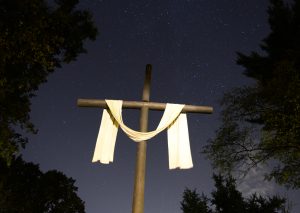
Few institutions today inspire more contempt among God-fearing Americans than Hollywood. Just the name of “Hollywood” conjures up images of glitzy, degenerate celebrities in gaudy outfits who use their wealth and influence to wage war on what remains of Christian morality.
Much subtler than this sexual immorality, yet ultimately more damaging, is the spread of a revolutionary mentality that denies the Catholic Faith at its deepest level by denying the effects of the Original Sin of Adam. It considers the purpose of life on this Earth to be the pursuit of bodily and material happiness. Therefore, suffering in any form and in any degree is the worst of evils. According to this mentality, it must be eradicated as quickly and efficiently as medicine, science, and technology will allow.
We may call this mentality “The Spirit of Hollywood.” Like a drop of oil on a sheet of paper, it has penetrated into the very fibers of our culture. And it is one of the primary causes of our modern crisis, from family dysfunction to drug abuse and virtually every other social evil we see today.
Some of its most bitter fruits are found, naturally, in Hollywood itself. A particularly salient example was the suicide of actor and comedian Robin Williams. Few in Hollywood personified success and carefree optimism like Robin Williams. He had a global fan base, universal recognition, prestige and wealth. In short, he was the paragon of worldly success.
On August 11, 2014, the world was shocked to discover that he killed himself in his San Francisco home. His personal assistant discovered him hanging by a belt from a door frame in his bedroom. The San Francisco Chronicle was mystified, reporting that the 63-year-old was “a man who seemingly had everything but inexplicably decided to hang himself.”1
Women’s March Feminists Brawl Over Who is More Equal
After his suicide, the facts slowly started to come out. For years he had been an alcoholic and had even taken hard drugs such as cocaine. He suffered from depression. We do not know all the factors that led to his drug abuse, depression, and suicide. But we do know that drugs, gross sexual immorality, depression, alcohol abuse, and suicide are so common in Hollywood that they are the norm, not the exception.
By no means is this spirit and its tragic effects exclusive to Hollywood. The culture of Silicon Valley, for example, shares this utopian philosophy. They believe that every human problem, and therefore every source of suffering, can be solved. One just needs to found the right startup, develop the right technology, and write the proper algorithm. We can even escape the ultimate suffering: death.
Tragically, the spirit of Hollywood has become the default mentality of the nation, with results that are as disastrous as they are predictable. The generation of Americans living in the first decades of the twenty-first century is arguably the unhappiest, dysfunctional, and suicidal generation in history. According to The New York Times, one-third of American adults and adolescents suffer from anxiety.2 Drug overdoses now kill more people than both firearms and car accidents.3 More than 60% percent of firearms deaths are not murders, but suicides.4
In 2011, suicide passed homicide as the second leading cause of death among teenagers.5
Is It Immodest to Wear Deliberately Ripped Clothes?
Denial of Original Sin
The Catholic Church teaches that death and suffering are a consequence of Original Sin which we inherited from Adam. After Original Sin, all men have in themselves a very strong tendency towards sin, disorder, and malice. Each person suffers the effects of Original Sin in a slightly different way, but we all feel pulled to have a distaste for virtue, order, duty, and goodness. Fundamental to Catholic spirituality is the call to wage unceasing warfare within ourselves against this disgust for order by turning ourselves towards God and Our Lady in prayer and the Sacraments. If not, we run the risk that this thirst for sin and distaste for order will triumph within us.
Mankind Needs Suffering
Imagine if we were to take a man conceived in Original Sin, with all the defects and bad tendencies it brings with it, and place him in a place like the Garden of Eden. He would be surrounded by every physical delight, but the simple fact of not experiencing any sufferings would begin to cause in him a certain malaise, uneasiness, boredom, and ultimately unhappiness and frustration.
Why? Because after Original Sin human nature requires the challenges of trials, hardships, and suffering to develop our qualities and practice virtue. Without hardship and adversity, we simply cannot develop ourselves.
What does Saint Thomas Aquinas say about Marriage?
Suffering is a type of oxygen for virtues. Without this special oxygen, our virtues wither and die, or never grow at all. Even if our hypothetical person never committed a mortal sin, without trials and sufferings he would never rise to any level of virtue, much less any form of the grandeur of soul like that of a saint.
The “Suffritive” Faculty
God created human nature with certain faculties, or powers. We have the intellectual faculties and the “sensitive” faculties, our five senses. These faculties are good in themselves.
Professor Plinio Corrêa de Oliveira described a phenomenon he observed in the human soul that, while not a true faculty, by analogy may be considered one. He called it the “suffritive” faculty. It is the capacity and even psychological need of the human soul, due to Original Sin, for suffering. In other words, we need suffering in a similar way that our bodies need exercise, our minds need stimulation, and our souls need beauty.
Take exercise. After Original Sin, our bodies need a certain amount of exercise to stay fit. We build up energy inside that needs to be expended. Without exercise, our bodies begin to get irritable and feel bad. The suffering caused by this ill-feeling is worse than the fatigue from exercising. On the contrary, we usually feel a great well-being after exercise.
Likewise, when this “suffritive” faculty is not exercised we experience emptiness and frustration.

True Source of Happiness
True happiness on this Earth only comes when we accept all the sufferings that God sends us in function of our individual vocation in life. When we discern our personal vocation in life and make our lives revolve around it, give it our whole heart, soul and mind, and cheerfully accept every suffering that God deigns to send our way, we attain true earthly joy in anticipation of the eternal bliss of Heaven.
Our Lord Jesus Christ illustrated this in the Gospel with the woman about to give birth. The apprehension that she has for what is to come may be very great, and she may suffer terrible pain when the time comes to give birth, but after the child is born her sorrow is immediately turned into joy for having brought a new person into the world. Although maternity is full of sufferings, the woman who fulfills her earthly vocation of mother and accepts those sufferings also experiences true joy. She can look back with satisfaction for having endured those trials and fulfilled her mission.
The same can be said for men who suffer in war. Veterans often consider their service to have been the highlight of their lives, and look back with fondness on the times when they suffered and sacrificed for their country.
Evil Helps Man Understand Goodness
Evil and suffering can perform a valuable function for mankind. We better understand good in itself when comparing it with evil. Human psychology learns things best through contrasts, and this applies especially to good and evil. By contrast we are able to understand things more profoundly.
For example, consider the great heresies of the early Church. Arianism, Nestorianism, Gnosticism, Manichaeism, Iconoclasm, Pelagianism, and the other heresies were some of the worst evils that ever afflicted the Catholic Church. They took many souls to Hell. However, these heresies were the occasion for the development of the Church’s theology and doctrines. The Church grew in the understanding of the divine truths when She was obliged to refute and condemn these errors. The Nicene Creed, for example, was written to refute the many heretical notions of the nature of God, Our Lord Jesus Christ, and the Church.
We truly understand better the beauty, goodness and grandeur of Our Lord Jesus Christ contrasting it with the malice, perfidy, filthiness and dishonor of Judas.
A civilization that seeks to hide all that is disagreeable and pretends that evil does not exist, that seeks to eradicate all suffering, that forms and deforms its culture, art, and literature, in accordance with this worldview, that embraces the sweet things of this Earth while rejecting the cross, produces a soft, saccharine society destined to decay.
How a Catholic Should Face Suffering
A true Catholic should face suffering with heroism and take the opposite attitude of the world. We must prepare ourselves for it and accept the suffering God sends us. Some Catholics have the mistaken idea that temptation is a catastrophe and is even looked at as a sign that the person is in spiritual decadence. A person simply should not suffer temptations. The spiritual life should glide ahead as a train glides over the rails.
On the contrary, the Catholic should confront suffering not like someone who trembles with worry at the thought of a coming disaster, but like a hunter in the African bush tracking down a lion for the kill. When a hunter encounters a lion, he doesn’t think to himself: “Oh no, what a disaster! There is a lion over there! Poor me! What am I going to do?”
Evil and suffering are like that lion. We must seek out that lion for the kill. It is beautiful and heroic to hunt down that lion, and cowardly and shameful to flee from it. The lion is not a disaster, but an occasion for heroism.

“Friends of the Cross”
Perhaps the greatest treatise on the glory and grandeur of suffering is Saint Louis-Marie Grignion de Montfort’s Letter to the Friends of the Cross.6 This short work is a treasure of doctrine and counsels to those Catholics who truly wish to live out their consecration of slavery to Our Lady. It is for those few who desire to walk the hard and narrow path up the heights of sanctity, waging warfare against the enemies of Our Lord and His Church.
What does he mean by “the Cross”? The cross is the ensemble of all that we ought to suffer to save our souls. It comprises, first of all, the efforts required for our sanctification; second, the misfortunes that befall us; and thirdly, our personal limitations and restrictions.
Sanctification involves pruning our souls of bad inclinations due to Original Sin and actual sin.
Misfortune is the lot of every human being. There is no one who does not suffer any misfortunes in life. Professor Corrêa de Oliviera commented how, when he was a boy, the older pious women in São Paulo, when describing a misfortune or disaster, used to use the expression “God visited me.” Catholics of that time still retained the idea that misfortune was, in fact, a gift from God for our own betterment and sanctification.
Limitations can be a source of suffering, whether they be of intelligence, ability, temperament, or any other quality. We are often tempted to compare ourselves with others and be envious of their superiorities. Rather than envy what others have, we must be content with what God gave us and, above all, admire what He in His infinite wisdom bestowed upon others.
 The “Great Way” and the “Little Way”
The “Great Way” and the “Little Way”
Professor Plinio Corrêa de Oliveria describes two ways to carry one’s cross. The first is the classical way or the “Great Way.” It is the way that the saints of the past such as Saint Ignatius of Loyola, Saint Teresa of Avila, or Saint Alphonsus de Liguori embraced suffering. They saw their duty before them, they saw it was a great suffering to be confronted, they made a mature deliberation of that suffering and a manly act of the will, and finally a gradual yet methodical execution.
Our generation, however, with its brokenness, weakened will, and sins, has a much harder time carrying its crosses. We are, so to speak, spiritually handicapped. The great sufferings of the martyrs and saints often frighten us. We feel our own insufficiency very deeply.
That is where Our Lady comes in. We should approach her and ask, “My Mother, I am too weak to confront these duties. The simple thought makes me tremble. If you wish this from me, give me a special grace, work in my soul, quickly, sublimely, with special efficacy. With the single interplay of ordinary grace, I am not able. So I beg you for enthusiasm, favors, aids, whereby, at a certain moment, my poor soul will be capable.”
Our Lady takes the weak soul and carries it on her shoulders, with much sweetness and ease. The cross still exists, but it is no longer so heavy. This is Saint Thérèse of Lisieux’s way of carrying one’s cross.
The Great Architect
Saint Louis de Montfort compares God to a great architect, and each one of us is a living stone with which God will build His Church:
You are not ignorant that you are the living temples of the Holy Ghost, and that you must, like so many living stones, be placed by this God of love into the building of the heavenly Jerusalem. Expect therefore to be molded, cut and chiselled by the hammer of the Cross; otherwise, you would remain like rough stones that are good for nothing, despised and rejected. Make sure that the hammer strikes you and be careful with the chisel that cuts you and the hand that turns you! Perhaps this skilful and loving architect wants to make you one of the first stones of his eternal edifice and one of the most beautiful portraits of his heavenly kingdom. So let him do it; He loves you, He knows what He is doing, He has experience; all his blows are dexterous and loving; He never misses one, unless you render it useless by your impatience. (Letter to the Friends of the Cross, no. 28).
Our Lady and “Enlevo”
The essence of our Sacred Slavery of Love to Our Lady according to Saint Louis de Montfort’s method is the desire to consecrate oneself in order to receive her mentality. Her mentality is, above all, the Spirit of the Cross.
Inherent to this grace is a subtle yet very radical transformation in the soul. He begins to have what Prof. Corrêa de Oliviera called enlevo. Enlevo is a Portuguese word that means “a marveling and sweeping admiration.” It is an admiration that is so strong that it makes a person desire to give himself entirely to the object of his admiration, and desire to serve, obey, and even make of himself a holocaust for that object. The only way for the cross to be attractive is to consider Him Who is nailed to it and to receive from Him the necessary strength to accept it. Love for the cross is born from our enlevo for the things of God, for Our Lord’s Passion, for the Church.
A Friend of the Cross Is a Crusader
A Friend of the Cross, a soul that has enlevo for the Passion, Cross and Death of Our Lord will naturally desire to fight the enemies of the Cross. He is naturally combative. Saint Louis de Montfort did not preach a Spirit of the Cross that was mediocre or self-pitying. On the contrary, he considers the Friends of the Cross to be an invincible army of crusaders in a fight to the death with the enemies of the Church:
You are united together, Friends of the Cross, like so many crusaders, to fight the world, not by fleeing like men and women religious, for fear of being vanquished, but as valiant and brave warriors on the battlefield, without giving ground or turning their backs. Courage! Fight valiantly! Join strongly in a union of minds and hearts, infinitely stronger and more terrible to the world and to hell than are the armed forces of a great kingdom to its enemies. The demons unite to destroy you; you must unite to defeat them. The avaricious unite to trade and amass gold and silver; you must unite your efforts to obtain the treasures of eternity, hidden in the Cross. Libertines join together to enjoy themselves; you must be united to suffer. (Letter to the Friends of the Cross, no. 2).
Our calling as Catholics is to oppose the errors of our times. If we are to be true Friends of the Cross we must resist conforming ourselves to these errors and be highly imbued with the truths that this age denies. It is the complete rejection of our age and all of its hatred for the Cross of Christ.
[like url=https://www.facebook.com/ReturnToOrder.org]
It would be an understatement to say that we live in times of extraordinary crisis. Extraordinary times of crisis require extraordinary heroism. Moral relativism is the greatest enemy that the Church and Christian civilization have ever faced. This threat is far worse than the Turks at the Battle of Lepanto or even the lions of the Roman arena. We need a heroism proportional to this threat.
A faithful slave of Our Lady, a true Friend of the Cross, receives this heroism. He receives a moral heroism which gives the strength of soul to endure great trials, deceptions, calumnies, failures, everything that man can expect to endure in this life, and above all the great moral heroism of confronting the errors of our day. Our Lady will grant him special graces of heroism, confidence, and perseverance until the final victory in this great Crusade of the twenty-first century, a victory promised one hundred years ago at Fatima, the triumph of Her Immaculate Heart.
1. Peter Fimrite, Evan Sernoffsky and Henry K. Lee, SFGATE, “Grim details of Robin Williams’ death released by investigators” updated August 13, 2014, at https://www.sfgate.com/bayarea/article/Investigators-Robin-Williams-hanged-himself-5683229.php
2. Benoit Denizet-Lewis, The New York Times Magazine, “Why Are More American Teenagers Than Ever Suffering From Severe Anxiety?” October 11, 2017, at https://www.nytimes.com/2017/10/11/magazine/why-are-more-american-teenagers-than-ever-suffering-from-severe-anxiety.html
3. AP on CBS News, “Drug overdoses now kill more Americans than guns” first published on December 9, 2016, updated on December 11, 2016, at https://www.cbsnews.com/news/drug-overdose-deaths-heroin-opioid-prescription-painkillers-more-than-guns/
4. Margot Sanger-Katz, The New York Times, “Gun Deaths Are Mostly Suicides” on October 8, 2015, at https://www.nytimes.com/2015/10/09/upshot/gun-deaths-are-mostly-suicides.html
5. Alicia Vanorman and Beth Jarosz, “Suicide Replaces Homicide as Second-Leading Cause of Death Among U.S. Teenagers” published June 9, 2016, at http://www.prb.org/Publications/Articles/2016/suicide-replaces-homicide-second-leading-cause-death-among-us-teens.aspx or https://www.prb.org/suicide-replaces-homicide-second-leading-cause-death-among-us-teens/
6. Saint Louis de Montfort, Letters to the Friends of the Cross at http://www.ewtn.com/library/Montfort/lfcross.htm


